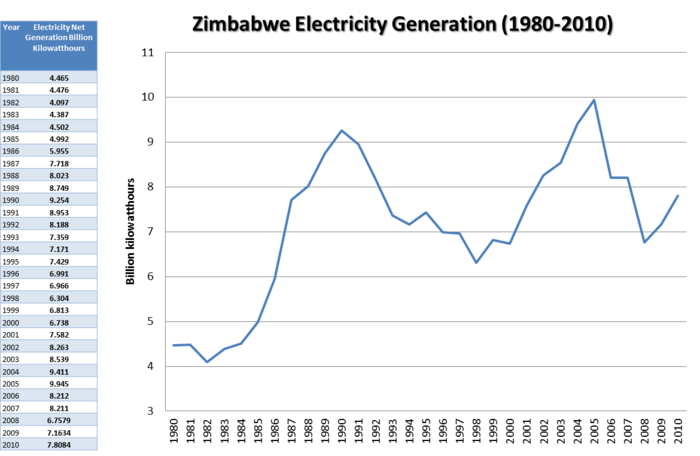Knowledge fuels change
For over a decade, Energypedia has shared free, reliable energy expertise with the world.
We’re now facing a serious funding gap.
Help keep this platform alive — your donation, big or small, truly matters!
Thank you for your support
Difference between revisions of "Zimbabwe Energy Situation"
***** (***** | *****) m |
***** (***** | *****) m |
||
| Line 196: | Line 196: | ||
<references /> | <references /> | ||
| + | [[Category:Zimbabwe]] | ||
[[Category:Country_Energy_Situation]] | [[Category:Country_Energy_Situation]] | ||
| − | |||
Revision as of 10:15, 6 September 2013
| Zimbabwe | |||
|
Capital |
Harare | ||
|
Official language(s) |
Chewa, Chibarwe, English | ||
|
Government |
Presidential System | ||
|
President |
Robert Gabriel Mugabe | ||
|
Total area |
390,757 km2 | ||
|
Population |
12 973 808 (2012 Estimate)[2] | ||
|
Rural population |
(year) | ||
|
GDP (nominal) |
US$ 10.978 billion (2013 Estimate)[3] | ||
|
GDP Per capita |
US$ 589 (2013 Estimate)[3] | ||
|
Currency |
Various[4] | ||
|
Time zone |
Central Africa Time (UTC+2) | ||
|
Electricity generation |
7.8084 billion kilowatthours (2010)[5] | ||
|
Access to Electricity |
% | ||
|
Wind energy (installed capacity) |
MW(Year) | ||
|
Solar Energy (installed capacity) |
MW (Year) | ||
Overview
(give a short overview of the country's energy situation, status quo including energy supply and consumption. If this is too much information, split into sub headings)
Energy Sources

| Energy Production | ||||
| 2005 | 2007 | 2008 | 2009 | 2010 |
|
|
|
|
|
Hydropower
Solar Energy
Biomass
Biogas
Wind Energy
Geothermal Energy
Fossil Fuels
Key Problems of the Energy Sector
Policy Framework, Laws and Regulations
General Energy Policy, Energy Strategy
Important Laws and Regulations
Specific Strategies
(Biomass, Renewable Energies, Rural Electrification, Energy Access Strategy, Poverty Reduction Strategy etc.)
Institutional Set-up in the Energy Sector
Activities of Donors and Implementing Agencies
Further Information
References
- ↑ The following languages, namely Chewa, Chibarwe, English, Kalanga, Koisan, Nambya, Ndau, Ndebele, Shangani, Shona, sign language, Sotho, Tonga, Tswana, Venda and Xhosa, are the officially recognised languages of Zimbabwe. Available at: http://www.kubatana.net/docs/legisl/constitution_zim_draft_copac_130125.pdf
- ↑ "Census Results in Brief". Zimbabwe National Statistical AgencyfckLRAvailable at: http://www.zimstat.co.zw/dmdocuments/CensusPreliminary2012.pdf
- ↑ 3.0 3.1 International Monetary Fund. Available at: http://www.imf.org/external/pubs/ft/weo/2012/01/weodata/weorept.aspx?pr.x=46&pr.y=0&sy=2009&ey=2012&scsm=1&ssd=1&sort=country&ds=.&br=1&c=698&s=NGDPD%2CNGDPDPC%2CPPPGDP%2CPPPPC%2CLP&grp=0&a=
- ↑ The Zimbabwean dollar is no longer in active use after it was officially suspended by the government due to hyperinflation. The United States dollar (US$), South African rand (R), Botswana pula (P), Pound sterling (£) and Euro (€) are now used instead.[9] The United States dollar has been adopted as the official currency for all government transactions. Source: http://en.wikipedia.org/wiki/Zimbabwe
- ↑ U.S. Energy Information Administration. Available at: http://www.eia.gov/countries/country-data.cfm?fips=ZI#elec
- ↑ 6.0 6.1 6.2 6.3 6.4 African Union/African Energy Commission. "African Energy Statistics 2012". Available at: http://www.afrec-energy.org/Docs/FR/PDF/2012/AEIS_FR_EN.pdf



















